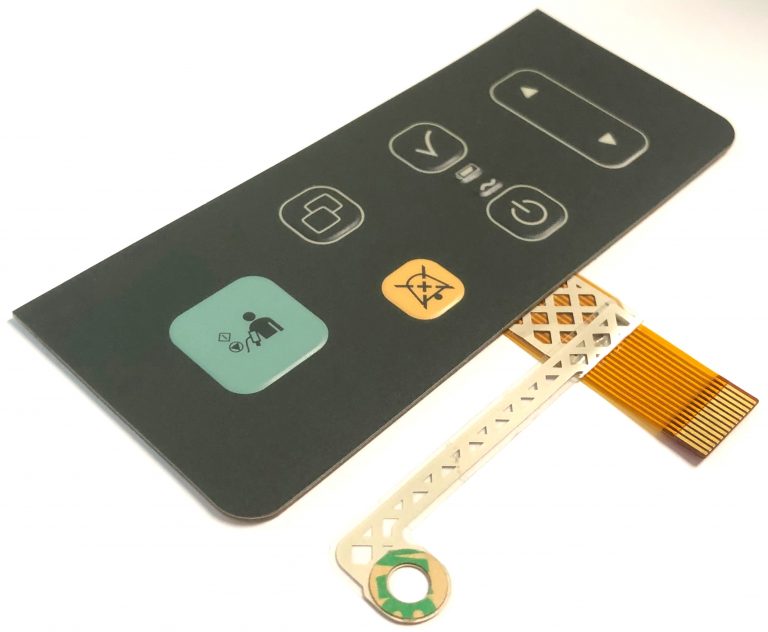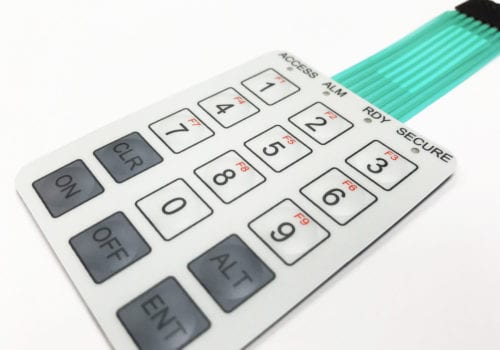Projects requiring high standards should always involve a qualified membrane switch manufacturer from the start.
Projects requiring high standards should always involve a qualified membrane switch manufacturer from the start.
Blog Article
What to Look for When Picking a Membrane Layer Switch for Your Project
When you're selecting a membrane layer switch for your task, numerous essential variables enter play. You'll need to consider the materials, layout, and just how well it straightens with your brand. Resilience and use are necessary, yet so is the online reputation of the supplier. Recognizing these elements can help you make a notified decision-- one that balances quality and cost successfully. Let's explore what you must think about to ensure your option satisfies all your project needs.
Recognizing Membrane Switch Components
When you plunge into the world of membrane layer switches, it's crucial to realize the key elements that make them function. The switch typically contains three main layers: the visuals overlay, the spacer layer, and the circuit layer. The graphic overlay provides the visual user interface, showing buttons and icons you need for easy navigation. Beneath that, the spacer layer assurances there suffices range between the circuit and the overlay, allowing the button to turn on without constant stress.
The circuit layer, usually made from printed conductive inks, creates the electrical pathways. When you push a switch, the circuit shuts, sending a signal to the gadget. Recognizing just how these layers interact aids you choose a membrane layer switch that's reliable and fits your project needs. Pay close attention to the thickness and material of each layer, as these elements affect resilience and performance in numerous settings.
Material Selection and Its Effect
Selecting the right materials for your membrane button can substantially impact its efficiency and longevity. The option of substratum, typically polyester or polycarbonate, influences sturdiness and flexibility. Polyester is more abrasion-resistant, while polycarbonate offers far better clarity and strength.
Following, take into consideration the adhesive. It requires to stand up to environmental aspects like moisture and temperature level changes. A solid sticky warranties that your membrane switch stays intact over time.
Do not neglect about the visuals overlay. The printing technique used, whether silkscreen or electronic, impacts the button's aesthetics and long life. High-grade inks will stand up to fading and damaging, keeping a specialist appearance.
Last but not least, consider environmental problems. If your device will be exposed to rough chemicals or extreme temperature levels, pick products designed to sustain these challenges. Your options in products will eventually identify the button's reliability and customer fulfillment.
Design Considerations for Individual Experience
Choosing the ideal materials lays the structure for a successful membrane layer switch, yet the layout also plays a substantial function in customer experience. You'll desire to reflect on exactly how the format impacts usability (membrane switch manufacturer). Maintain switches and symbols user-friendly and well-spaced, making it very easy for individuals to browse without confusion

Shade and contrast are likewise essential; guarantee that your design is visually enticing yet still practical. High contrast assists individuals conveniently identify buttons, particularly in low-light problems.
Last but not least, review the general visual. A streamlined and modern-day design can raise individual understanding and make your product extra attractive. Stabilizing capability with an interesting style will cause a better user experience and eventually, a more effective item.

Environmental Aspects and Toughness
When picking a membrane layer switch, you require to consider exactly how it'll do in numerous settings. Variables like temperature level resistance, dampness and chemical direct exposure, and mechanical wear can greatly influence its durability. Recognizing these elements will help you pick a button that withstands your details problems.
Temperature Resistance Requirements
As environmental conditions can differ commonly, comprehending temperature resistance is necessary for ensuring the longevity of your membrane layer switch. You need to evaluate the temperature level variety in which your device will run. High temperatures can create materials to deteriorate, leading to failing, while low temperature levels might make components breakable and vulnerable to splitting. Make certain to check the specs of the materials used in the button, like the sticky and overlay, as they directly impact performance. It's additionally a good idea to contemplate possible temperature variations and their impacts on the switch's integrity. By selecting a membrane layer switch with appropriate temperature resistance, you'll enhance its life-span and preserve performance in tough atmospheres. Pick sensibly to stay clear of costly substitutes down the line.

Dampness and Chemical Exposure
Wetness and chemical direct exposure can significantly impact the performance and long life of your membrane layer button, so it's vital to recognize the setting in which it will be used. If your job entails high moisture or exposure to fluids, try to find protective finishings and sealants that can boost resistance to wetness. Furthermore, consider the kinds of chemicals your button might experience. Specific materials can deteriorate when subjected to solvents, oils, or extreme cleansers. Choosing the ideal products, like polycarbonate or polyester, can aid stand up to these elements. Always get in touch with the manufacturer's specs for chemical compatibility to ensure your membrane switch preserves its performance in time. By focusing on moisture and chemical resistance, you can improve the resilience of your switch in tough environments.
Mechanical Deterioration
While you may prioritize functions like visual appeals and functionality in your membrane button, mechanical wear and tear can greatly influence its efficiency over time. Constant pushing can lead to destruction of products, triggering issues like responsive comments loss or also change failure. Selecting a sturdy More hints switch guarantees longevity and dependability, preventing pricey substitutes and downtime in your task.
Modification Options for Branding
When it comes to branding your membrane button, modification choices are key. You can choose design elements and shades that reflect your brand, along with specific logo design placement and dimension to enhance exposure. Furthermore, selecting the best materials and textures can boost the overall feel and look, making your product stand apart.
Layout Elements and Colors
A wide variety of style components and shades can make your membrane layer switch not just practical however likewise visually attractive, boosting your brand identification. When picking shades, think of your brand name's combination; they should reverberate with your target market and evoke the right feelings. You can additionally explore various coatings like matte or glossy to create different aesthetic effects. Do not forget appearances; including a tactile element can boost individual experience and make your switch attract attention. Think about integrating customized graphics or patterns that align with your brand name message. By attentively picking design aspects and colors, you not just develop an item that looks terrific but additionally reinforces your branding continually and effectively.
Logo Design Positioning and Size
After settling your style elements and shades, the following action is to concentrate on logo placement and size. Your logo design is a vital facet of your branding, so you'll desire it to stand out without overwhelming other style components. Review where your logo design will certainly be most visible and impactful; usual positionings consist of the top or center of the switch.
Do not neglect to consider how the logo straightens with user communication. This attention to information will certainly enhance both capability and Recommended Site brand identity in your task.
Product and Structure Choices
Choosing the appropriate materials and appearances for your membrane layer switch can considerably improve both its functionality and aesthetic charm. You'll want to review alternatives like polyester or polycarbonate, as they offer toughness and resistance to use. The texture of the surface area additionally plays an essential function; smooth finishes give a streamlined look, while distinctive surfaces can boost grip and responsive feedback.
Personalizing the products and textures allows you to mirror your brand name identity successfully. As an example, you could choose a matte coating to share class or a shiny search for a modern-day touch - membrane switch manufacturer. Do not neglect about color alternatives, as dynamic hues can make your switch attract attention, while muted tones can create a much more elegant appearance
Cost vs. High Quality: Discovering the Right Balance
When you're managing the options for membrane layer switches, stabilizing cost and quality can feel frustrating. A lower-cost switch might conserve you money upfront, yet if it jeopardizes performance, you could face higher substitute expenses later.
Seek makers that offer a great mix of affordability and high criteria. Research their online reputation and consumer reviews to gauge reliability. In some cases, investing a bit much more in quality materials can conserve you from future frustrations.
Also, take into consideration the pop over to this site lasting performance and warranty alternatives. A somewhat much more costly button with a strong warranty might verify to be a smarter investment. Ultimately, it has to do with locating that pleasant area where you fulfill your budget plan while ensuring your job's success.
Evaluating and Quality Control Protocols
While you might find the best membrane switch design, ensuring its top quality via extensive testing protocols is important for long-term success. Beginning by verifying that the maker follows market criteria, such as IPC/WHMA-A -620, to assure a dependable product. membrane switch manufacturer. You'll want to look for thorough testing approaches, consisting of ecological, mechanical, and electrical evaluations
Make sure the switches undergo toughness screening, imitating real-world use to determine any potential failings. Take notice of the maker's quality control procedure, which need to consist of regular assessments and audits.

Don't fail to remember to request for samples and conduct your own examinations to confirm compatibility with your project. Take into consideration just how commonly the producer updates their procedures; advancement in testing can lead to enhanced high quality. By focusing on these testing and quality control procedures, you'll enhance the possibility of a successful and long lasting membrane layer switch for your application.
Often Asked Inquiries
For how long Does a Membrane Switch Commonly Last?
A membrane switch generally lasts anywhere from 1 to 10 million cycles, depending on use and environmental aspects. You'll wish to consider your particular requirements to guarantee it satisfies your durability demands efficiently.
Can Membrane Changes Be Fixed if Harmed?
Yes, you can occasionally fix membrane buttons if they're damaged, but it typically relies on the level of the damages. Small concerns could be fixable, while much more significant damages generally needs replacement for proper capability.
What Are the Usual Applications for Membrane Switches?
Membrane switches are commonly utilized in home appliances, medical gadgets, and auto controls. You'll locate them in consumer electronic devices, industrial equipment, and also video gaming consoles. Their flexibility makes them optimal for numerous user interfaces and atmospheres.
Exist Particular Qualifications for Membrane Buttons?
Yes, there are certain accreditations for membrane switches. Try to find UL, CE, and RoHS accreditations to guarantee safety and security and conformity. These qualifications indicate the switch satisfies industry requirements for quality and ecological security.
Exactly how Do I Guarantee Correct Installment of a Membrane Layer Switch Over?
To assure correct installation of a membrane layer button, clean the surface extensively, straighten it carefully, and use even pressure. Comply with producer standards for adhesive curing time to make best use of toughness and capability.
Conclusion
When picking a membrane layer button for your job, keep these vital consider mind: focus on durable materials, concentrate on easy to use design, and think about customization for your brand. Equilibrium expense and quality by researching respectable suppliers with solid quality guarantee methods. By thoroughly evaluating these facets, you'll assure your membrane layer button not just satisfies your project needs however additionally improves customer experience and shows your brand identification efficiently. Make an educated choice, and your job will thrive!
Report this page